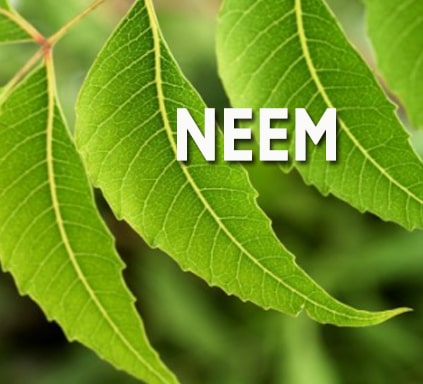
NEEM
BOTANICAL NAME:- Azadirachta indica
FAMILY:- Meliaceae
COMMON NAMES:-
Hindi:- Neem
Sanskrit:- Nimb
English name:- Margosa tree
Parts used- Leaves, Seeds, Flowers, Bark, Oil
Distribution-
The neem is native of Indian subcontinent, it is widely distributed mainly in the drier (arid) tropical and subtropical zones of Asia, Africa, the Americas, Australia and the South Pacific islands In India it is widely distributed in many states In Myanmar it is very common in the central parts of the country. It thrives in areas with sub-arid to sub-humid conditions.
Active Constituents
The most important active constituent is Azadirachtin are Nimbolinin, Nimbin, Nimbidin, Nimbidol, Sodium nominate, Sedunin, Salannin, and Quercetin Leaves contain ingredients such as Nimbin, Nimbanene, 6-desacetylnimbinene, Nimbandiol, Nimbolide, Ascorbic acid, n-hexacosanol, Amino acid and Nimbiol Quercetin and ß-sitosterol, Polyphenolic flavonoids, are present in fresh leaves Seeds hold valuable constituents including Gedunin and Azadirachtin.
USES-
Antimicrobial– Neem and its ingredients play role in the inhibition of growth of numerous microbes & have potent Antibacterial, Antiviral, Antimalarial & Antifungal activities. Plant’s parts show antimicrobial role through inhibitory effect on microbial growth/potentiality of cell wall breakdown.
Antioxidant– Its plays role as free radical scavenging properties due to rich source of antioxidant. Azadirachtin and Nimbolide showed concentration-dependent antiradical scavenging activity and reductive potential in the following order: Nimbolide > Azadirachtin > Ascorbate. Leaf aqueous extract, flower, stem & bark extracts showed higher free radical scavenging effect
Anticancerous– Neem ingredient (Flavanoids) shows effective role in the management of cancer through the regulation of cell signaling pathways. It modulates the activity of various tumour suppressor genes, angiogenesis, transcription factors, and apoptosis
Antiinflammatory– It also plays role as anti-inflammatory via regulation of proinflammatory enzyme activities including cyclooxygenase (COX), and lipoxygenase (LOX) enzyme
Hepatoprotective– Leaf extract significantly prevented changes in the serum levels of Bilirubin, Protein, Alanine Aminotransferase, Aspartate Aminotransferase, and Alkaline Phosphatase and significantly prevented the histological changes
Wound healing effect– Leaves extracts of Azadirachta indica promote wound healing activity through increased inflammatory response and neovascularization
Antidiabetic–Leaf extracts show hypoglycemic action, shows a good oral glucose tolerance and significantly reduces the intestinal glucosidase activity
Immunomodulatory and Growth Promoting Effect– Various studies showed neem leaves infusion on broiler chicks improves antibody titer, growth performance & enhances humoral and cell-mediated immune response.
Neuroprotective– Antioxidant compounds in Neem help to prevent brain damages, by enhancing lipid peroxidation and increasing ascorbic acid (Vitamin C) in the brain.
Nephroprotective– Leaves extract of Azadirachta indica effectively rescues the kidney from various medications like Cisplastin mediated oxidative damage
Neem as an immunity booster
Neem is widely prescribed to reduce fever, especially malaria. Science has identified Neem as an “Immunomodulator,” meaning that it supports the innate immune’s system ability to self-regulate — either up, in times of defense, or down, to avoid over-activity that can lead to what is known as a “Cytokine Storm,” when the immune system becomes dysregulated. Research suggests that “the ethanol extract of Neem leaves showed in vitro antibacterial activity against Staphylococcus .


